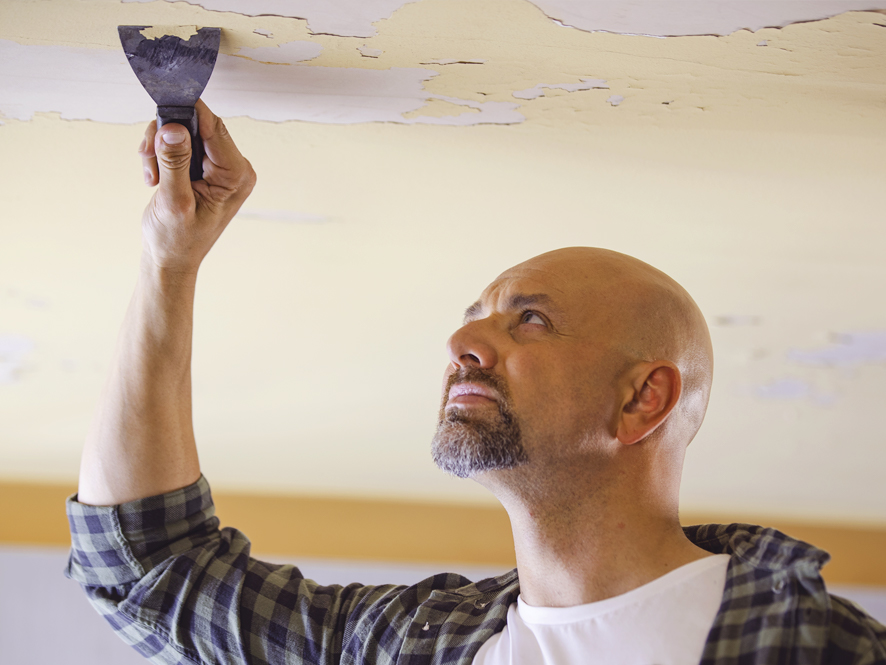Introduction
The pristine canvas of your ceiling can quickly turn into a canvas of frustration when chips and dents mar its smooth surface. Whether it’s from roughhousing kids or the aftermath of a water leak, chipped ceiling paint can be an eyesore that tarnishes the aesthetic of your home. But fear not! With a little elbow grease and the right know-how, you can restore your ceiling to its former glory. In this definitive guide, we’ll delve into the how-to’s of fixing chipped ceiling paint, empowering you to tackle this home improvement task with confidence.

Image: www.artcomcrea.com
Understanding the Chipped Ceiling Menace
Before diving into the repair process, let’s understand the why behind ceiling paint chips. These cracks and dents can arise due to various reasons, including:
- Structural shifts in the ceiling
- Moisture and water damage
- Impact from objects
- Poor adhesion during painting
Identifying the root cause can help you prevent future chips and ensure the durability of your ceiling paint.
Step-by-Step Repair Guide
1. Safety First: Gather Your Tools
Before you embark on your paint restoration mission, gather the following tools:
- Spackling paste
- Spackling knife
- Sandpaper (fine-grit)
- Filler primer
- Paint roller and brush
- Ceiling paint
- Drop cloth
2. Prep the Battlefield: Clear the Area
Spread a drop cloth beneath the chipped area to catch debris and protect your floor from splatter. Remove any furniture or obstacles that might hinder your work.
3. Assess the Damage: Spot the Chipped Areas
Carefully examine the ceiling and mark the chipped areas with a pencil or chalk. This will guide your repair efforts and ensure you address all the imperfections.
4. Remove Loose Paint: Scrape Away the Flaky Bits
Use a spackling knife to gently scrape away any loose or flaking paint around the chipped areas. This will create a smooth surface for the spackling paste to adhere to.
5. Fill the Cracks: Apply the Spackling Paste
Dip your spackling knife into the paste and apply it to the chipped area. Fill the dents completely, using the knife to smooth out the surface. Allow the spackling paste to dry according to the manufacturer’s instructions, usually 24 hours.
6. Sand and Prime: Smooth It Out
Once the spackling paste is dry, sand the repaired area with fine-grit sandpaper until it’s flush with the rest of the ceiling. Brush away any dust and apply a thin coat of filler primer to seal the patch and ensure better paint adhesion. Let the primer dry for a few hours.
7. Paint Away: Restore the White Canvas
With the primer dry, it’s time to restore your ceiling’s pristine look. Use a paint roller to apply a thin layer of ceiling paint over the patched area and extend the paint slightly beyond it. Allow the first coat to dry completely, then apply a second coat for a seamless finish.
8. Celebrate Your Success: Enjoy the Renewed Ceiling
Step back and admire your handiwork. Your ceiling is now back to its former glory, without a trace of the pesky chips that once marred its beauty.

Image: ilabb20.blogspot.com
How To Fix Chipped Ceiling Paint
https://youtube.com/watch?v=Lks3lQUf0o8
Expert Insights and Actionable Tips
- Seek professional help for large or severe ceiling paint damage.
- Use a spackling paste specifically designed for ceiling repairs.
- Allow ample drying time between each step, as rushing the process can compromise the repair’s durability.
- If the chipped area is on a textured ceiling, use a texture matching compound to restore the original texture.
- Regular cleaning and maintenance of your ceiling can prevent future chipping and keep it looking pristine.










